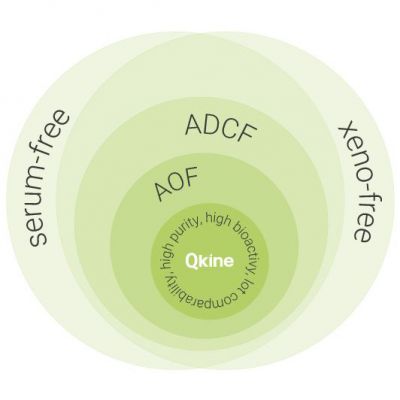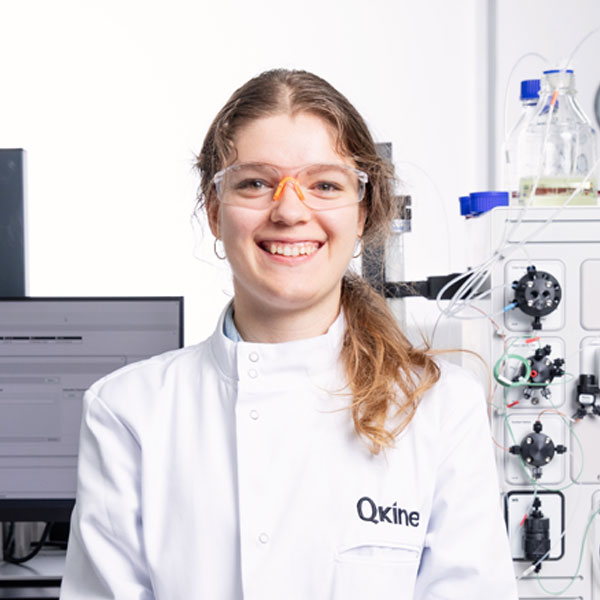Recombinant growth factors and cytokines are essential components in the successful culture of stem cells for translational research and the development of cellular agriculture. To preserve pluripotency, stem cells require exposure to consistent levels of specific growth factors and cytokines. The instability of recombinant protein media components can increase the need for frequent media changes to preserve cell conditions and this is costly.
Qkine strives to produce the most high-quality growth factors and cytokines for stem cell culture. Qkine ensures lot-to-lot consistency in bioactivity, high purity and animal origin-free production.
Why is growth factor stability so important?
Fibroblast growth factor-2 (FGF-2) stability in culture
FGF-2 is a key component of stem cell media, it is known to be unstable under cell culture conditions, leading to the necessity for daily media changes to maintain culture conditions for stem cell culture. Qkine has developed FGF2-G3 a thermostable modification of FGF-2 to allow weekend-free culture protocols. Although the thermo-instability of FGF-2 is well documented, the thermostability of other essential growth factors has not been investigated.
This application note reviews the stability of Qkine growth factors under cell culture-like conditions to ensure maximum cost effectiveness and reproducibility in stem cell cultures.
A

B
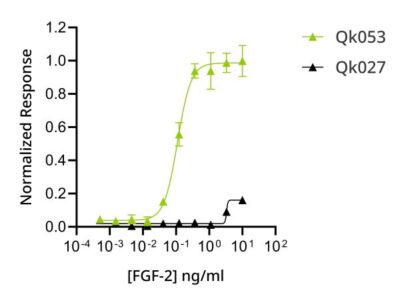
Stability testing of Qkine growth factors
Conditioned media was collected from HEK293T cells cultured for 72 h in DMEM + 10% FBS and filtered. Qkine recombinant growth factors and cytokines GM-CSF, IL-6, IGF-1, GDNF, and HGF were reconstituted in phosphate buffered saline (PBS), BMP-4 and TGF-β1 in HCl reconstitution buffer at 1 mg/ml. Proteins were diluted to 0.5 mg/ml in PBS then diluted in HEK293T conditioned media. Recombinant proteins in media were incubated at 37°C, 5% CO2 and samples were taken at 0, 1, 2, 5 and 7 days. SDS-PAGE was used to assess stability at each time point and luciferase reporter or cell proliferation bioassays were used to assess bioactivity.
Granulocyte-macrophage colony-stimulating factor (GM-CSF)
A
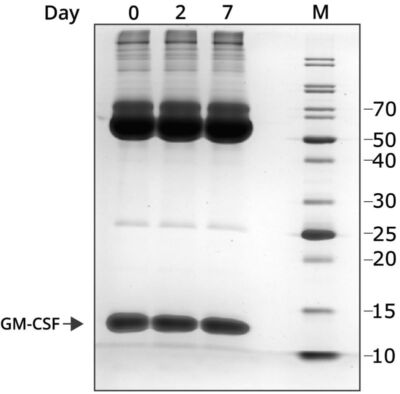
B

Stability and bioactivity of Qkine GM-CSF (Qk076). SDS-PAGE of recombinant GM-CSF (A), protein was not degraded when incubated in HEK293T conditioned media for 7 days. Bioactivity was determined using proliferation of TF-1 human myeloid leukaemia cells (B). Cells were treated in triplicate for 48 hours with a serial dilution of GM-CSF which had been pre-incubated in conditioned media for 2 or 7 days. Cell viability was measured using CellTiter-Glo (Promega) luminescence assay.
Recombinant human GM-CSF protein (Qk076) remained stable in conditioned media over the 7 days; its bioactivity was comparable on day 0 (EC50 38.3 ng/ml), day 2 (EC50 35.4 ng/ml) and day 7 (EC50 47.8 ng/ml).
Interleukin-6 (IL-6)
A
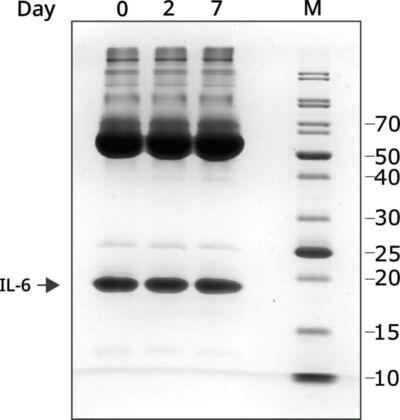
B

Stability and bioactivity of Qkine IL-6 (Qk093). SDS-PAGE of recombinant IL-6 (A), protein was not degraded when incubated in HEK293T conditioned media for 7 days. Bioactivity was determined using the IL-6-responsive firefly luciferase reporter assay (B). Transfected HEK293T cells were treated in triplicate for 24 hours with a serial dilution of IL-6 which had been pre-incubated in conditioned media for 2 or 7 days. Firefly luciferase activity was measured and normalised to the control Renilla luciferase activity.
Recombinant human IL-6 protein (Qk093) remained stable in conditioned media over the 7 days; its bioactivity was comparable on day 0 (EC50 2.5 ng/ml), day 2 (EC50 2.2 ng/ml) and day 7 (EC50 1.8 ng/ml).
Insulin-like growth factor 1 (IGF-1)
A

B
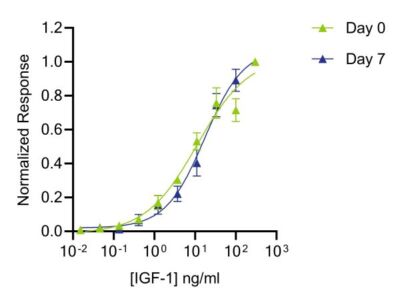
Stability and bioactivity of Qkine IGF-1 (Qk047). SDS-PAGE of recombinant IGF-1 (A), protein was not degraded when incubated in HEK293T conditioned media for 7 days. Bioactivity was determined using an IGF-1-responsive firefly luciferase reporter assay (B). Transfected HEK293T cells were treated in triplicate for 4 hours with a serial dilution of IGF-1 which had been pre-incubated in conditioned media for 7 days. Firefly luciferase activity was measured and normalised to the control Renilla luciferase activity.
Recombinant human/bovine/porcine IGF-1 protein (Qk047) remained stable in conditioned media over the 7 days; it was as bioactive at day 0 (EC50 11.2 ng/ml) as it was at day 7 (EC50 17.2 ng/ml). IGF-1 is known to be relatively unstable in cell cultures, potentially due to the presence of metabolically active cells. However, in these experiments IGF-1 retained integrity and activity over 7 days.
Insulin-like growth factor 1 (IGF-1) LR3
A
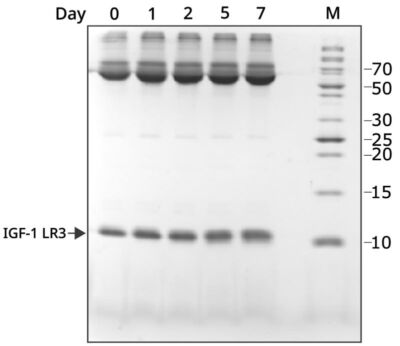
B

Stability and bioactivity of Qkine IGF-1 LR3 (Qk041). SDS-PAGE of recombinant IGF-1 LR3 (A), protein was not degraded when incubated in HEK293T conditioned media for 7 days. Bioactivity was determined using the IGF-1 LR3-responsive firefly luciferase reporter assay (B). Transfected HEK293T cells were treated in triplicate for 4 hours with a serial dilution of IGF-1 LR3 which had been pre-incubated in conditioned media for 2 or 7 days. Firefly luciferase activity was measured and normalised to the control Renilla luciferase activity.
Recombinant human/bovine/porcine IGF-1 LR3 (Qk041) is a synthetic analog of IGF-1, modified to increase stability and reduce binding to inhibitory IGF-1 binding protein (IGFBPs). IGF-1 LR3 protein remained stable in conditioned media over the 7 days, it was bioactive at day 0 (EC50 15.5 ng/ml), day 2 (EC50 14.6 ng/ml) and day 7 (EC50 23 ng/ml).
Glial cell line-derived neurotrophic factor (GDNF)
A

B
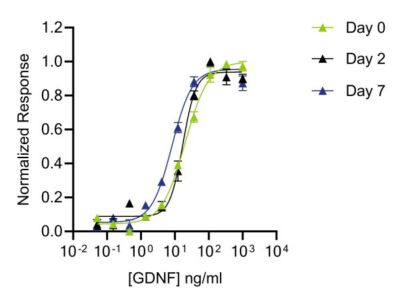
Stability and bioactivity of Qkine GDNF (Qk051). SDS-PAGE of recombinant GDNF (A), protein was degraded when incubated in HEK293T conditioned media for 1, 2, 5 or 7 days. Bioactivity was determined using proliferation of SH-SY5Y cells (B). Cells were treated in triplicate for 3 days in the presence of retinoic acid and recombinant GFR α1 with a serial dilution of GDNF which had been pre-incubated in conditioned media for 2 or 7 days. Cell viability was measured using CellTiter-Glo (Promega) luminescence assay.
Recombinant human GDNF protein (Qk051) was progressively degraded over the 7 days in conditioned media. However, despite protein degradation occurring over the 7 days the bioactivity remained stable at day 0 (EC50 20.1 ng/ml), day 2 (EC50 17.3 ng/ml) and increased by day 7 (EC50 8.2 ng/ml). Indicating that the portion of the GDNF which is responsible for activity remained intact.
Bone morphogenetic protein 4 (BMP-4)
A

B
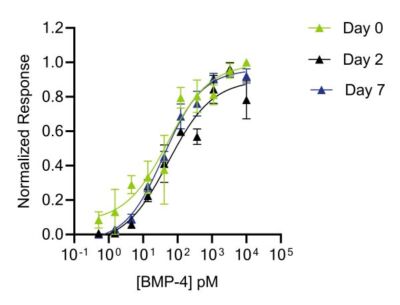
Stability and bioactivity of Qkine BMP-4 (Qk038). SDS-PAGE of recombinant BMP-4 (A), protein was not degraded when incubated in HEK293T conditioned media for 7 days. Bioactivity was determined using the BMP-4-responsive firefly luciferase reporter assay (B). Transfected HEK293T cells were treated in triplicate for 6 hours with a serial dilution of BMP-4 which had been pre-incubated in conditioned media for 2 or 7 days. Firefly luciferase activity was measured and normalised to the control Renilla luciferase activity.
Recombinant human BMP-4 protein (Qk038) remained stable in conditioned media over the 7 days, it was bioactive at day 0 (EC50 51.2 pM), day 2 (EC50 53.6 pM) and day 7 (EC50 40 pM).
Hepatocyte growth factor (HGF) NK1
A

B
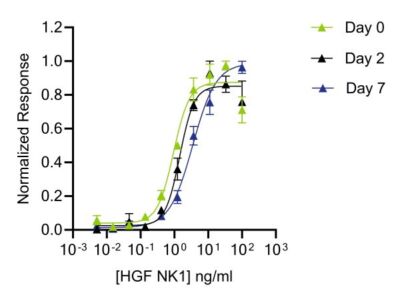
Stability and bioactivity of Qkine HGF NK1 (Qk013). SDS-PAGE of recombinant HGF NK1 (A), protein was partially degraded when incubated in HEK293T conditioned media for 7 days. Bioactivity was determined using the HGF NK1-responsive firefly luciferase reporter assay (B). Transfected HEK293T cells were treated in triplicate for 6 hours with a serial dilution of HGF NK1 which had been pre-incubated in conditioned media for 2 or 7 days. Firefly luciferase activity was measured and normalised to the control Renilla luciferase activity.
HGF NK1 is a potent naturally occurring isoform of HGF. HGF NK1 protein showed some degradation over the 7 days. The bioactivity was also slightly decreased over time, however HGF NK1 was bioactive at day 0 (EC50 0.9 ng/ml), day 2 (EC50 1.4 ng/ml) and day 7 (EC50 3.5 ng/ml).
Transforming growth factor-beta 1 (TGF-β1) PLUS
A
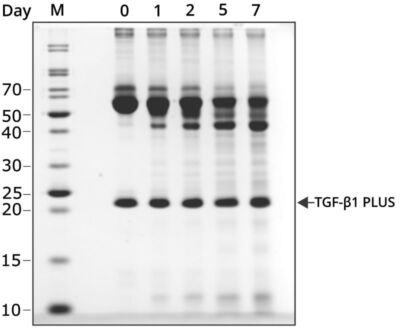
B

Stability and bioactivity of Qkine TGF-β1 PLUS (Qk010). SDS-PAGE of recombinant TGF-β1 (A), protein was not degraded when incubated in HEK293T conditioned media for 7 days. Bioactivity was determined using a TGF-β1-responsive firefly luciferase reporter assay (B). Transfected HEK293T cells were treated in triplicate with a serial dilution of TGF-β1 which had been pre-incubated in conditioned media for 2 or 7 days. Firefly luciferase activity was measured and normalised to the control Renilla luciferase activity.
Recombinant human/bovine/porcine TGF-β1 protein (Qk010) remained stable in conditioned media over the 7 days, it was bioactive at day 0 (EC50 28.3 pg/ml), day 2 (EC50 23.8 pg/ml) and day 7 (EC50 19.5 pg/ml).
Stability of tested Qkine growth factors and cytokines
Bioassays demonstrated that all tested growth factors maintained their bioactivity after 7 days in conditioned media, determining the thermostability of the proteins. During stem cell applications, cultured cells will be metabolically active, and this may have additional influence on growth factor stability, degradation and activity.
Stem cell culture models are developed for the study of disease and for cultivated meat applications. Stem cells require consistent exposure to essential growth factors to produce reproducible cell phenotypes. The stability of Qkine recombinant growth factors and cytokines in cell culture provide consistent cell culture conditions and reduce the need for daily media changes.
Further information
Qkine growth factors are manufactured to the highest of quality standards and are free from animal-derived contaminants, delivering low endotoxicity and high purity. At Qkine, we are committed to raising the standards of growth factors, cytokines and related proteins to better support long-term and complex neural stem cell culture. We are a science-led team, please reach out with any questions or requests to support@qkine.com
